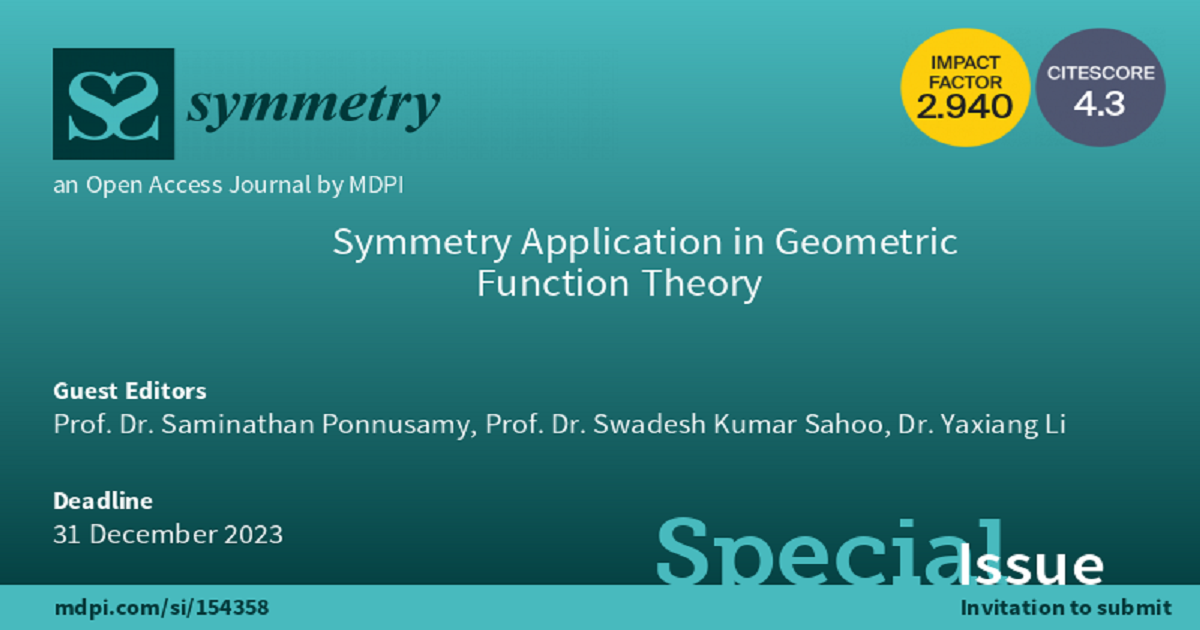Symmetry Application in Geometric Function Theory
A special issue of Symmetry (ISSN 2073-8994). This special issue belongs to the section "Mathematics".
Deadline for manuscript submissions: closed (31 December 2023) | Viewed by 7050

Special Issue Editors
Interests: geometric function theory
Interests: geometric function theory
Special Issue Information
Dear Colleagues,
Geometric function theory is an active research field of mathematics dealing with one and higher-dimensional complex analysis—in particular, with numerous applications in both mathematical sciences and engineering fields (for instance, the theory of harmonic mappings, analysis of PDEs, quasiconformal and quasiregular mappings, special functions, and fluid flow problems). Geometric function theory and symmetry are closely related; for instance, Möbius transformation theory and hyperbolic geometry both use symmetric principles. Additionally, function theory has extensively explored starlike functions with regard to symmetric points. The geometry of mappings and domains can be referred to as geometric function theory.
The main goal of publishing this Special Issue is to promote global cooperation, particularly in symmetry applications in the field of geometric function theory. A wide spectrum of function theorists and geometers from around the world are invited to contribute in order to accomplish this goal. The majority of the Special Issue will focus on the following areas of geometric function theory that are still relevant today: univalent harmonic mappings, hyperbolic-type geometries, function spaces, quasiconformal and quasiregular mappings, and function theory, all of which play a key role in obtaining applications.
The study of geometric analysis, function spaces, and metric measure spaces has attracted an increasing amount of attention in recent years. In physics, mechanics, and other application domains, harmonic mappings and analysis on PDEs have been developed, and they serve as a breakthrough in identifying new issues. Studying the general characteristics of geometric function theory is, thus, very important for science. One of the most significant applications of geometric function theory is found in neuroscience, among other fields of study, through conformal brain mappings.
The purpose of this Special Issue is to present a number of papers that concentrate on symmetry and its uses in geometric function theory. It also hopes to act as a spark for fresh ideas and new cooperative endeavours devoted to exploring the amazing insights into numerous branches of science and engineering.
Prof. Dr. Saminathan Ponnusamy
Prof. Dr. Swadesh Kumar Sahoo
Dr. Yaxiang Li
Guest Editors
Manuscript Submission Information
Manuscripts should be submitted online at www.mdpi.com by registering and logging in to this website. Once you are registered, click here to go to the submission form. Manuscripts can be submitted until the deadline. All submissions that pass pre-check are peer-reviewed. Accepted papers will be published continuously in the journal (as soon as accepted) and will be listed together on the special issue website. Research articles, review articles as well as short communications are invited. For planned papers, a title and short abstract (about 250 words) can be sent to the Editorial Office for assessment.
Submitted manuscripts should not have been published previously, nor be under consideration for publication elsewhere (except conference proceedings papers). All manuscripts are thoroughly refereed through a single-blind peer-review process. A guide for authors and other relevant information for submission of manuscripts is available on the Instructions for Authors page. Symmetry is an international peer-reviewed open access monthly journal published by MDPI.
Please visit the Instructions for Authors page before submitting a manuscript. The Article Processing Charge (APC) for publication in this open access journal is 2400 CHF (Swiss Francs). Submitted papers should be well formatted and use good English. Authors may use MDPI's English editing service prior to publication or during author revisions.
Keywords
- symmetry
- Möbius and hyperbolic groups
- univalent functions
- harmonic and quasiconformal mappings
- functions spaces
- hyperbolic-type metric geometry
- geometric analysis and PDEs
Benefits of Publishing in a Special Issue
- Ease of navigation: Grouping papers by topic helps scholars navigate broad scope journals more efficiently.
- Greater discoverability: Special Issues support the reach and impact of scientific research. Articles in Special Issues are more discoverable and cited more frequently.
- Expansion of research network: Special Issues facilitate connections among authors, fostering scientific collaborations.
- External promotion: Articles in Special Issues are often promoted through the journal's social media, increasing their visibility.
- Reprint: MDPI Books provides the opportunity to republish successful Special Issues in book format, both online and in print.
Further information on MDPI's Special Issue policies can be found here.





